So I was pretty skeptical approaching Quantumdada Phase 2, up now at Rudolph Blume. (Even more skeptical after reading Michael Bise's evisceration of "Phase 1.") And in terms of saying anything interesting about quantum physics or science in general, my skepticism was rewarded. But that doesn't mean that the art was bad. On the contrary, I thought it was a pretty decent collection of pieces. The less literal they were, the less they tried to be about physics, the better they were.
Michael Brims, Oval Eyes Shaking, video, 2010
Curator Eisele Volker writes "'Oval Eyes Shaking' represents the conscious observer of this room [the front gallery]. Every room has its own conscious observer in order to represent Dada consciousness and to, hopefully, interact with the quantum world." Boy, is he putting a lot of responsibility on Michael Brims' wacky video. I like this video not because it seems in any way to "represent Dada consciousness," but because it feels like Brim has created a video version of Googly Eyes. (And of course, being the rock nerd that I am, I was also reminded of this classic.) But what I found a little weird about Volker's description was that he hoped it would interact with the quantum world. His hopes should be amply fulfilled, since like all matter and energy, Brim's video is continuously interacting with the quantum world, as the electrons in every atom in the room achieve their stochastically determined quantum states... But I assume that's not what Volker meant. But I'll confess that I don't have a clue what he means by yoking Dada and quantum physics together. Dada was a reaction to the insanity of mankind, which was slaughtering itself by the millions as the first Dadaists performed on the stage at Cabaret Voltaire. Quantum physics, as strange as its results are, is the result of supreme acts of ratiocination. Dada is deliberately irrational.

Kevin Jones, Blend, photographs
This may be my favorite piece in the show. While I don't see a connection with quantum physics, there is a connection with science. This kind of photodocumentation seems typical of how a scientist would observe a movement--carefully, deliberately, obsessively, from a single vantage point. One thinks of the work of Eadweard Muybridge and Harold Edgerton. Of course, the irony was that those to photo pioneers were capturing images that the human eye couldn't discern, whereas Kevin Jones is capturing images that we can easily see for ourselves, but would be far too boring to watch. Jones solves the boredom problem by showing them all simultaneously. The viewer doesn't have to wait for the snail to complete his transit.
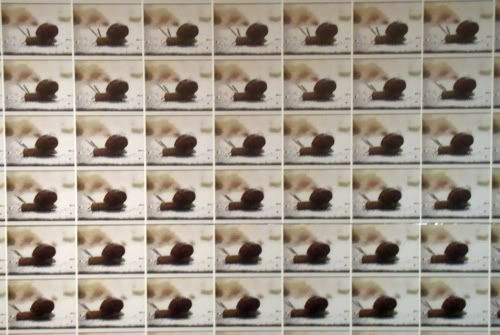
Kevin Jones, Blend detail, photographs
Also in the "science-y" vein is The Path of Least Resistance by Ariane Roesch.
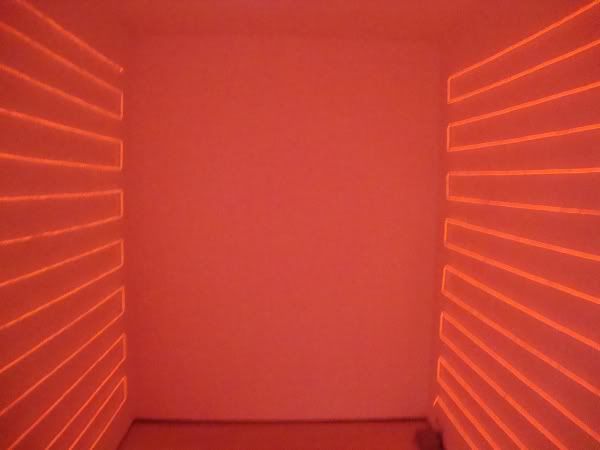
Ariane Roesch, The Path of Least Resistance, Electroluminescent Wire, 2010
Ariane Roesch has been using EL Wire in her work for a while now. EL Wire is a very clever product; basically, it is simply copper wire coated with phosphor.
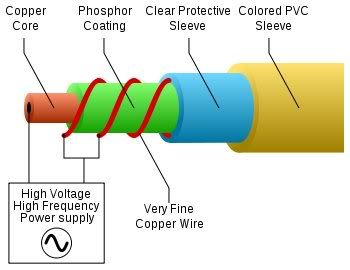
Of all the pieces here, this is one where a principle of quantum physics is perhaps most at its core. As electricity travels through wire, the energy causes electrons in the phosphor molecules to become excited and jump up to a higher energy level (a quantum leap). When the electrons fall, they release photons. The principle with EL Wire is not terribly different from fluorescent lamps (and like them, EL Wires are very efficient).
Being in that room had another science-y association for me.
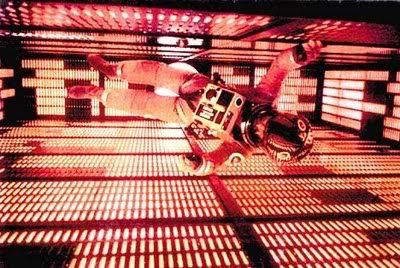
I wonder if Roesch were deliberately recalling the scene in 2001 where Bowman slowly, carefully kills HAL.
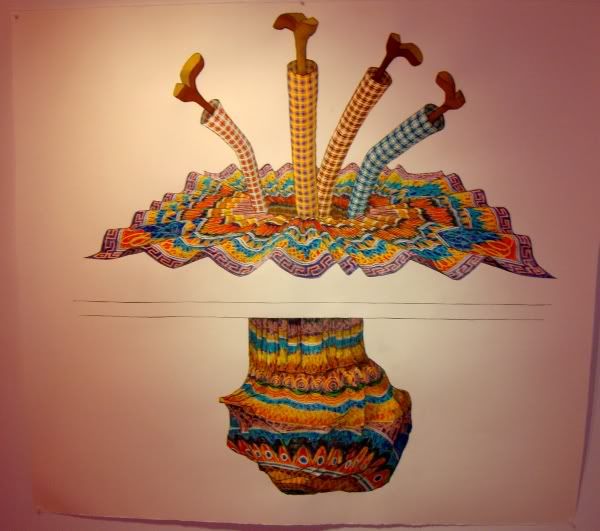
Daniel Heimbinder, Entanglement, colored marker on paper
One has to wonder whether Daniel Heimbinder was inspired by the concept of quantum entanglement or if he just happened to have created one of his brilliant cartoon images--the offsprint of a Philip Guston painting and a Saul Steinberg drawing--that also just happened to work with that word, "entanglement." His entanglement and quantum entanglement are unrelated. His bears a closer relationship to the Marx Brothers than to Richard Feynman.
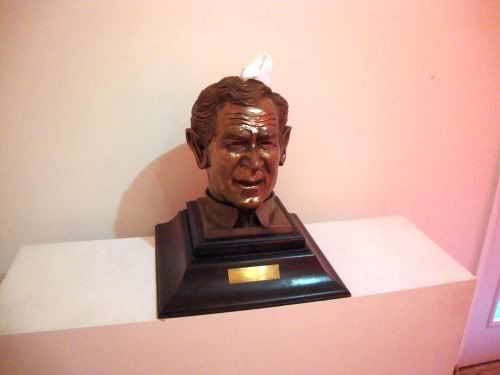
Greg Metz, George W Bush as a Kleenex dispenser, sculpture bust with tissue
Here is a piece by Greg Metz that has no obvious relationship to quantum physics at all, and only a slight one to Dada (insofar as both were anti-war expressions). The plaque reads "MY DEEPEST REGRETS TO THOSE WHO HAVE SACRIFICED THEIR LOVED ONES FOR MY IRAQ WAR". This sentiment is mocked by the goofy smile on Bush's face, and by the inadequacy of offering a tissue to a grieving spouse or parent. It's a pretty brutal, bitter piece, and it works where so many other political works fail by being personal. George Bush and his failure as a person are the subject.
You will notice that the last two pieces have a somewhat orange tint to them. That is not local color. It's the result of sharing a small room with David Graeve's piece, an orange balloon, 8 feet in diameter, hung from the ceiling. The room itself was hardly 12 feet square (I'm guessing), so this balloon dominated the room. The light reflected off the balloon gave everything an orange tint (not as orange as in Ariane Roesch's room, of course). I couldn't take a picture of it--there was no place within the room where I could get the whole balloon into my viewfinder.
This show had as its objective the task of "connecting aspects of the quantum world with the world of art as Dada." In that regard, it is a failure. However, the better way to look at the show is to ignore its stated objective and consider it as a heterogeneous collection of artworks, some good, some less so. Leave the curatorial conceit behind and see it as a group show. On this basis, I recommend it. There are pieces here worth seeing.

No comments:
Post a Comment